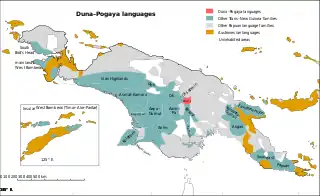| Duna–Pogaya | |
|---|---|
| Duna–Bogaia | |
| Geographic distribution | Hela Province, Papua New Guinea |
| Linguistic classification | Trans–New Guinea
|
| Subdivisions | |
| Glottolog | None |
 Map: The Duna–Pogaya languages of New Guinea
The Duna–Pogaya languages
Other Trans–New Guinea languages
Other Papuan languages
Austronesian languages
Uninhabited | |
The Duna–Pogaya (Duna–Bogaia) languages are a proposed small family of Trans–New Guinea languages in the classification of Voorhoeve (1975), Ross (2005) and Usher (2018), consisting of two languages, Duna and Bogaya, which in turn form a branch of the larger Trans–New Guinea family.[1] Glottolog, which is based largely on Usher, however finds the connections between the two languages to be tenuous, and the connection to TNG unconvincing.[2]
Language contact
Duna has had significant influence on Bogaya due to the socioeconomic dominance of Duna speakers over the less populous, less influential Bogaya speakers.[3] Duna also has much more influence from Huli (a widely spoken Trans-New Guinea language) at 27–32 percent lexical similarity with Huli, while Duna has only 5-10 percent.[3]
Pronouns
Pronouns are:
sg du pl 1 *nó *ge-na *i-nu 2 *gó 3 *kó *ki-nu
Vocabulary comparison
The following basic vocabulary words are from McElhanon & Voorhoeve (1970),[4] Shaw (1973),[5] and Shaw (1986),[6] as cited in the Trans-New Guinea database:[7]
gloss Bogaya Duna head yeľʌ; yela kuni hair heepi; yeľʌ eľika hini ear hona; hɔnʌn kɔhane; konane eye kina; kiːnʌn le nose kuuma; pfouľu kuma tooth yagai; yʌkʌi ne; nee tongue iki; ɩkin ogone; ɔgɔne leg yehei; yehʌi tia louse fando; fiľʌ tete dog ɔv̧ɔpi; yau yawi pig ʌpʌn isa bird aka; pitʌkʌ heka egg oondi; pitʌkʌ ɔ̃udi hapa blood sokoya; yesʌ kuyila bone hakale; hʌv̧ʌľe kuni skin hugwa; hukuʌn pulu breast alu; ʌľu abu; adu; amu tree dowa; tɔuʌ lowa; lɔwa man ami; ʌmĩ anoa; anɔa woman ĩmiʌ; imya ima sun owa; ɔwa hewa moon kaiyuu; kʌiu eke water paiyuku; pʌiuku yu fire dowada; tɔun lɔwa kiliana; lowa puru stone haana; hʌnʌ kana; kuna name ʌmĩn; yaga yaka eat nã; nosii nai-; neyana one mɔsʌ kɔmʌ; moso du two efʌn; yeefa yapa
Evolution
Duna reflexes of proto-Trans-New Guinea (pTNG) etyma are:[3]
- amu ‘breast’ < *amu
- konane ‘ear’ < *kand(e,i)k(V]
- kuni ‘bone’ < *kondaC
References
- ↑ NewGuineaWorld
- ↑ Hammarström, Harald; Forkel, Robert; Haspelmath, Martin, eds. (2017). "Bogaya". Glottolog 3.0. Jena, Germany: Max Planck Institute for the Science of Human History.
- 1 2 3 Pawley, Andrew; Hammarström, Harald (2018). "The Trans New Guinea family". In Palmer, Bill (ed.). The Languages and Linguistics of the New Guinea Area: A Comprehensive Guide. The World of Linguistics. Vol. 4. Berlin: De Gruyter Mouton. pp. 21–196. ISBN 978-3-11-028642-7.
- ↑ McElhanon, K.A. and Voorhoeve, C.L. The Trans-New Guinea Phylum: Explorations in deep-level genetic relationships. B-16, vi + 112 pages. Pacific Linguistics, The Australian National University, 1970. doi:10.15144/PL-B16
- ↑ Shaw, R.D. "A Tentative Classification of the Languages of the Mt Bosavi Region". In Franklin, K. editor, The linguistic situation in the Gulf District and adjacent areas, Papua New Guinea. C-26:187-215. Pacific Linguistics, The Australian National University, 1973. doi:10.15144/PL-C26.187
- ↑ Shaw, R.D. "The Bosavi language family". In Laycock, D., Seiler, W., Bruce, L., Chlenov, M., Shaw, R.D., Holzknecht, S., Scott, G., Nekitel, O., Wurm, S.A., Goldman, L. and Fingleton, J. editors, Papers in New Guinea Linguistics No. 24. A-70:45-76. Pacific Linguistics, The Australian National University, 1986. doi:10.15144/PL-A70.45
- ↑ Greenhill, Simon (2016). "TransNewGuinea.org - database of the languages of New Guinea". Retrieved 2020-11-05.
- Ross, Malcolm (2005). "Pronouns as a preliminary diagnostic for grouping Papuan languages". In Andrew Pawley; Robert Attenborough; Robin Hide; Jack Golson (eds.). Papuan pasts: cultural, linguistic and biological histories of Papuan-speaking peoples. Canberra: Pacific Linguistics. pp. 15–66. ISBN 0858835622. OCLC 67292782.